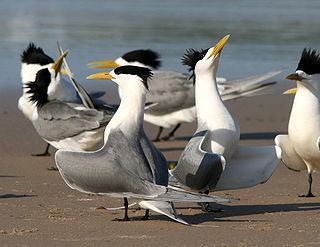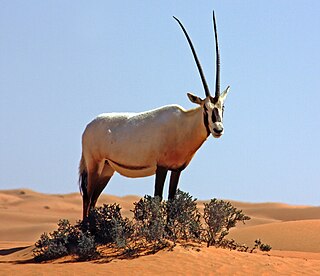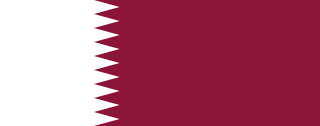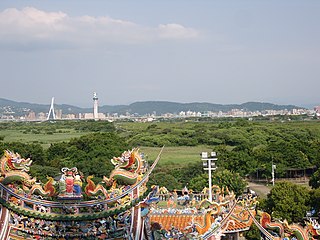
The Persian Gulf is a mediterranean sea in Western Asia. The body of water is an extension of the Indian Ocean through the Strait of Hormuz and lies between Iran to the northeast and the Arabian Peninsula to the southwest. The Shatt al-Arab river delta forms the northwest shoreline.

Qatar is a peninsula in the east of Arabia, bordering the Persian Gulf and Saudi Arabia, in a strategic location near major petroleum deposits. Qatar occupies 11,437 km2 (4,416 sq mi) on a peninsula that extends approximately to 160 km (99 mi) north into the Persian Gulf from the Arabian Peninsula.

The United Arab Emirates is situated in the Middle East/southwest Asia, bordering the Gulf of Oman and the Persian Gulf, between Oman and Saudi Arabia; it is at a strategic location along the northern approaches to the Strait of Hormuz, a vital transit point for world crude oil. The UAE lies between 22°50′ and 26° north latitude and between 51° and 56°25′ east longitude. It shares a 19 km (12 mi) border with Qatar on the northwest, a 530 km (330 mi) border with Saudi Arabia on the west, south, and southeast, and a 450 km (280 mi) border with Oman on the southeast and northeast.

The Kingdom of Bahrain consists of Bahrain Island and 33 of the 37 Bahrain Islands, lying in the Persian Gulf's Gulf of Bahrain off the north shore of Asia's Arabian Peninsula. Bahrain's capital city is Manama. The islands are about 24 kilometers (15 mi) off the east coast of Saudi Arabia and 28 kilometers (17 mi) from Qatar. The total area of the country is about 780 square kilometers (301 sq mi), about 3.5 times the size of the District of Columbia.

A typically used by Earth scientists, a sabkha is a coastal, supratidal mudflat or sandflat in which evaporite-saline minerals accumulate as the result of semiarid to arid climate. Sahbkas are gradational between land and intertidal zone within restricted coastal plains just above normal high-tide level. Within a sabkha, evaporite-saline minerals sediments typically accumulate below the surface of mudflats or sandflats. Evaporite-saline minerals, tidal-flood, and eolian deposits characterize many sabkhas found along modern coastlines. The accepted type locality for a sabkha is at the southern coast of the Persian Gulf, in the United Arab Emirates. Sabkha is a phonetic translation of the Arabic word used to describe any form of salt flat. Sabkha is also known as either sabkhah or sebkha, and coastal sabkha.
The wildlife of Iraq includes its flora and fauna and their natural habitats. Iraq has multiple biomes which include the mountainous Kurdistan region in northern Iraq to the wet marshlands along the Euphrates river. The western part of the country comprises desert and some semi-arid regions. As of 2001, seven of Iraq's mammal species and 12 of its bird species are endangered. The endangered species include the northern bald ibis and Persian fallow deer. The Syrian wild ass is extinct, and the Saudi Arabian dorcas gazelle was declared extinct in 2008.

The sooty gull is a species of gull in the family Laridae, also known as the Aden gull or Hemprich's gull. It is found in Bahrain, Djibouti, Egypt, Eritrea, India, Iran, Israel, Jordan, Kenya, Lebanon, Maldives, Mozambique, Oman, Pakistan, Qatar, Saudi Arabia, Somalia, Sri Lanka, Sudan, Tanzania, United Arab Emirates, and Yemen. As is the case with many gulls, it has traditionally been placed in the genus Larus. The sooty gull is named in honour of the German naturalist Wilhelm Hemprich who died in 1825 while on a scientific expedition to Egypt and the Middle East with his friend Christian Gottfried Ehrenberg.

The white-cheeked tern is a species of tern in the family Laridae. It is found around the coasts on the Red Sea, around the Horn of Africa to Kenya, in the Persian Gulf and along the Iranian coast to Pakistan and western India.

Island View Beach is located on the Eastern Cordova shore of the Saanich Peninsula, near Victoria, British Columbia, Canada.

Bahrain Island, also known as al-Awal Island and formerly as Bahrein, is the largest island within the archipelago of Bahrain, and forms the bulk of the country's land mass while hosting the majority of its population.

The Tanji Bird Reserve is a bird reserve in The Gambia. Established in 1993, it covers an area of 612 hectares. It is also known as Karinti, the Tanji River Reserve or the Tanji National Park.

Housing more than 200 resident and wintering bird species, Chennai has long been a haven for bird watchers. It is the one of the few urban areas in India with diverse range of birds including greater flamingo, black baza, osprey, Eurasian eagle-owl, malabar barbet, Spot billed pelican and pied avocet can be seen. The following are some known birding hotspots in and around Chennai.

The Sandy Island and Low Rock Important Bird Area comprises two small islands with a collective area of 9 ha lying at the western end of the Gulf of Carpentaria in the Northern Territory of Australia. They lie south-west of Groote Eylandt off the coast of Arnhem Land, with the nearest settlement there the Numbulwar community. They are important as breeding sites for terns.

The Swan Bay and Port Phillip Bay Islands Important Bird Area comprises a cluster of disparate sites centred at the eastern end of the Bellarine Peninsula, and the southern end of Port Phillip, in Victoria, south-eastern Australia. As well as providing core wintering habitat for orange-bellied parrots, it is important for waders, or shorebirds, and seabirds.
The wildlife of Bahrain is the flora and fauna of the archipelago of Bahrain, and is more varied than might be expected of this small group of islands in the Persian Gulf. Apart from a strip of the north and west of the main island, where crops such as potatoes are grown with irrigation, the land is arid. With a very hot dry summer, a mild winter, and brackish groundwater, the plants need adaptations in order to survive. Nevertheless, 196 species of higher plant have been recorded here, as well as about seventeen species of terrestrial mammals, many birds and reptiles, and a large number of migratory birds visit the islands in autumn and spring.

The wildlife of the United Arab Emirates is the flora and fauna of this country on the eastern side of the Arabian Peninsula and the southern end of the Persian Gulf. The country offers a variety of habitats for wildlife including the coast, offshore islands, mangrove areas, mudflats, salt pans, sand and gravel plains, sand dunes, mountain slopes, wadis and rocky summits. Because the terrain is so varied, it supports a greater number of species of plants and animals than might have been expected in this relatively small country.

Dagestan Nature Reserve is a Russian 'zapovednik' protects an area of sand dunes and ridges on the northwest coast of the Caspian Sea in the southeast of European Russia. The reserve, a wintering place for migratory birds, is the richest nature reserve in Russia in terms of the number of species - over 300 species have been recorded in the reserve, its buffer zones and subordinate reserves. The reserve is part of several "Important Bird and Biodiversity Areas" (IBAs). The Sarykum sand dune is the highest sand dune in Europe, at 262 m (860 ft). The reserve is situated in the Tarumovsky District of Dagestan.


























